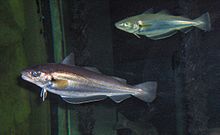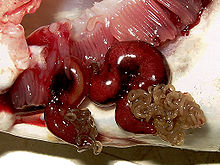- Merlangius merlangus
-
For other fish known as whiting, see Whiting (fish).
Whiting 
Scientific classification Kingdom: Animalia Phylum: Chordata Class: Actinopterygii Order: Gadiformes Family: Gadidae Genus: Merlangius Species: M. merlangus Binomial name Merlangius merlangus
(Linnaeus, 1758)Merlangius merlangus, commonly known as whiting (or 'English whiting' in the USA) is an important food fish in the eastern North Atlantic, northern Mediterranean, western Baltic, and Black Sea. In English speaking countries outside the whiting's natural range, the name has been applied to various other species of fish, see Whiting (fish) (disambiguation).
Until the later twentieth century, whiting was a cheap fish, regarded as food for the poor or for pets, but the general decline in fish stocks means that it is now more highly valued. The other fish that have been given the name whiting are mostly also food fish.
Parasites
Cod and related species are plagued by parasites. For example the cod worm, Lernaeocera branchialis, starts life as a copepod, a small free-swimming crustacean larva. The first host used by cod worm is a flatfish or lumpsucker, which they capture with grasping hooks at the front of their body. They penetrate the lumpsucker with a thin filament which they use to suck its blood. The nourished cod worms then mate on the lumpsucker.[1][2]
The female worm, with her now fertilized eggs, then finds a cod, or a cod-like fish such as a haddock or whiting. There the worm clings to the gills while it metamorphoses into a plump, sinusoidal, wormlike body, with a coiled mass of egg strings at the rear. The front part of the worms body penetrates the body of the cod until it enters the rear bulb of the host's heart. There, firmly rooted in the cod's circulatory system, the front part of the parasite develops like the branches of a tree, reaching into the main artery. In this way, the worm extracts nutrients from the cod's blood, remaining safely tucked beneath the cod's gill cover until it releases a new generation of offspring into the water.[1][2]
References
- ^ a b Matthews B (1998) An Introduction to Parasitology Page 73–74. Cambridge University Press. ISBN 9780521576918.
- ^ a b Extraordinary Animals: An Encyclopedia of Curious and Unusual Animals. Greenwood Press. 2007.
- "Merlangius merlangus". Integrated Taxonomic Information System. http://www.itis.gov/servlet/SingleRpt/SingleRpt?search_topic=TSN&search_value=164758. Retrieved 19 March 2006.
External links
This Gadiformes-related article is a stub. You can help Wikipedia by expanding it.


